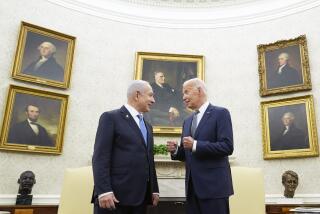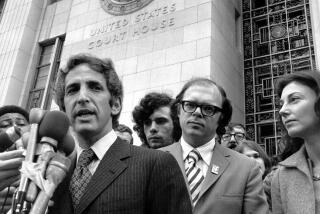Industry’s a Key Player in Energy Data
- Share via
WASHINGTON — The Bush administration Monday released thousands of documents on its energy task force, showing that industry groups provided substantial input in drafting the president’s energy plan.
In putting out 11,000 pages of documents before a midnight deadline, the Energy Department gave new ammunition to critics of the administration’s energy policy, who say it is tilted in favor of the coal, gas, oil and nuclear industries.
The documents show that Energy Secretary Spencer Abraham met with more than 30 industry representatives at eight sessions from Feb. 14 to April 26. The Nuclear Energy Institute, the Independent Petroleum Assn. of America and the American Coal Co. were among the business groups invited to those sessions.
No representatives of environmental or consumer groups were listed as meeting with Abraham.
In a statement, Abraham said the documents show that the energy plan was “balanced” and that the Energy Department “not only sought but included all viewpoints.” Department officials said they sought input from environmentalists but were often rebuffed. Environmental groups have said their calls to administration officials weren’t returned.
The department said that Abraham had declined a number of requests from business executives for meetings.
The documents did little to quell a legal and political controversy over the dealings of the energy task force, established by President Bush only days after he took office. Bush, a former oilman, named Vice President Dick Cheney, who had led an energy services company, to head the task force.
The administration’s refusal to provide details of the task force’s meetings led the General Accounting Office, the investigative arm of Congress, to file its first-ever lawsuit Feb. 22 against the executive branch. That lawsuit has not been resolved.
Separately, the Natural Resources Defense Council, an environmental organization, and Judicial Watch, a conservative watchdog group, successfully brought court cases forcing the Energy Department and other federal agencies that participated in the task force to make their records available.
Those two organizations had sought documents last spring under the Freedom of Information Act and sued when it appeared that the government was dragging its feet on those requests. The two judges in these lawsuits set Monday as the deadline to begin releasing the documents.
Energy Dept. Withholds Thousands of Pages
In addition to the Energy Department documents, about 5,000 pages of documents were released Monday by the Department of Agriculture, the Environmental Protection Agency and the Office of Management and Budget.
The Energy Department withheld 15,000 pages of documents. Of the 11,000 provided, many were heavily redacted. The omissions fanned the controversy over the task force’s secret meetings and contacts with industry groups, many of which were sources of sizable donations to the Bush-Cheney campaign.
Abel Lopez, director of an Energy Department office that deals with requests for records, said the deletions were permitted under the Freedom of Information Act, which “protects advice, recommendations and opinions” that are part of the executive branch’s decision-making process.
Such redaction is not uncommon. Under the Freedom of Information Act, government agencies may refuse to release information for a variety of reasons, including protecting an individual’s privacy or shielding policy debates.
But Judicial Watch officials accused the administration of holding back key records and vowed to return to court. “They’re withholding information that the public has a right to obtain,” said Larry Klayman, chairman and general counsel of the conservative watchdog group.
The documents were provided to a variety of environmental groups and media organizations, including The Times, which had requested the information under the Freedom of Information Act.
The documents show that the California energy crisis last year was a much-discussed topic at the Energy Department, with e-mails on the state’s troubles often flagged as high priority. But in most cases, the content of the e-mails was edited out.
“Virtually all the e-mails we have seen have been completely blanked out,” said John Walke, director of clean air programs for the Natural Resources Defense Council. “There are huge blank passages associated with the e-mails. Some of the sentences are cut off in the middle and redacted out in the bizarre way.”
Walke was particularly interested in learning about plans for the new source review provision of the Clean Air Act, which requires plants to install state-of-the-art pollution control devices when they renovate their plants in a way that increases pollution.
But while the phrase “New Source Review” or its abbreviation may appear in the subject or below an attachment icon, there is no text.
“It gives you nothing,” Walke said. “The substance is purposefully stricken from the document.”
Give-and-Take Revealed in E-Mails
Among the documents released were e-mails between energy officials, detailed schedules for the secretary’s chief of staff and other key officials, e-mails from citizens praising the plan or suggesting various technologies that would help solve the country’s energy woes.
Some of the e-mails from industry lobbyists and representatives to key members of the administration’s energy task force suggested that there was significant give-and-take in the development of the plan. For instance, the National Petrochemical and Refiners Assn. and the Nuclear Energy Institute supplied recommended paragraphs to drop into specific sections of the plan.
The release also included many documents already public, such as energy proposals from think tanks, environmental groups and industry associations; administration officials’ testimony to Congress; letters to the agency from members of Congress; and news reports on energy troubles from newspapers, wire services and broadcast outlets.
The EPA documents included appeals by the oil industry for reducing the number of gasoline formulas used across the country and by the auto industry for reevaluating the government’s fuel-economy standards. The administration’s plan called for studying both issues.
Democratic lawmakers contend that the energy industry, including scandal-plagued Enron Corp., heavily influenced shaping of a production-tilted energy policy that favors the oil, gas, coal and nuclear industries. Indeed, the administration has acknowledged that Enron officials met six times with task force officials, including once with Cheney himself.
The Republican-controlled House last summer approved an energy plan that included a number of the administration’s initiatives, including opening up the Arctic National Wildlife Refuge to oil and gas drilling. The Democratic-controlled Senate has been bogged down in a debate on a far different energy bill that would stress conservation over production.
The GAO is continuing to wage its legal battle to secure additional information, including White House records. Administration officials have said they may claim executive privilege--a doctrine that presidents from George Washington onward have used to withhold information from Congress or the judiciary--to maintain the confidentiality of Cheney’s records.
They also contend that releasing the information would set a bad precedent for future administrations seeking candid advice from outside experts.
White House spokesman Ari Fleischer said Monday that the release of the documents did not alter the White House’s opposition to making public the details of Cheney’s meetings.
“The constitutional principle that the president and the vice president have enunciated remains in place,” Fleischer said, “and the president will continue to fight for that.”
*
Times researcher Robert Patrick contributed to this report.
More to Read
Get the L.A. Times Politics newsletter
Deeply reported insights into legislation, politics and policy from Sacramento, Washington and beyond. In your inbox three times per week.
You may occasionally receive promotional content from the Los Angeles Times.











